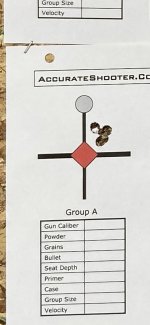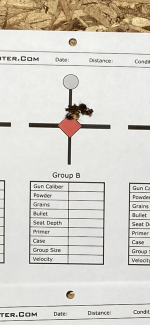Guys, my distance to lands is driving me nuts. I'm an engineer so the details and precision are something I can't let go off and I'm off deep into the rabbit hole. Would appreciate some perspective.
Have a GAP 280AI and had been measuring distance to lands every couple hundred rounds or so. The distance was decreasing with increasing round count (impossible). My measurement approach was a very loosely seated bullet in the same once-fired case (in my chamber), cycle the bolt closed, measure CBTO (hornady comparator guage/calipers), repeat several times to ensure consistency, log the info. The decreasing distance and some significant variation really had me questioning everything. Thus, I switched to the Wheeler method of measuring and this has led to at least very consistent results on 'kissing' the lands BUT.... this distance to kissing the lands is significantly shorter than what I was getting with the loose bullet seating/cycle bolt method especially on Berger VLD bullets. Here's the comparison data
Note the change in CBTO for each bullet to just 'kiss' the lands via WHEELER method vs previous results is significantly shorter.
So Here is my dilemma....
Up until now (prior to WHEELER measurements) I've been thinking i've testing various 'jump' distances during load development by seating the bullet deeper at increments of 'at the lands', -0.040", -0.070", -0.110" but in reality according to CBTO via WHEELER method I was actually, in the case of the Berger bullet, starting off jammed as much as +0.137" and never even seated the bullet deep enough to ever test any jump (what I thought was -0.110" / 2.680" was really still jammed +0.027" according to WHEELER measurements).
Notice with the Nosler 160g AB the difference in CBTO for WHEELER method vs base method was much less of a delta. Given this, I'm wondering when measuring CBTO via chambering a loose fitting bullet if the much more slender nose of the Bergers and Hornady AMAX results in more easily jamming the bullet very deep without even realizing it and in much higher measurement error/variation. Just seems crazy I was really jamming the bullet this much via previous method. Seems WHEELER method is a more precise/true measurement of just 'kissing' the lands.
Therefore, I think I need to re-test seating depth for all my loads using the WHEELER method as my chamber leade distance for each bullet and then test deeper seating depths vs that as my reference point. Does this sound right? Other Thoughts?
Appreciate any enlightenment you have to offer.... #frustrated
Kevin
Have a GAP 280AI and had been measuring distance to lands every couple hundred rounds or so. The distance was decreasing with increasing round count (impossible). My measurement approach was a very loosely seated bullet in the same once-fired case (in my chamber), cycle the bolt closed, measure CBTO (hornady comparator guage/calipers), repeat several times to ensure consistency, log the info. The decreasing distance and some significant variation really had me questioning everything. Thus, I switched to the Wheeler method of measuring and this has led to at least very consistent results on 'kissing' the lands BUT.... this distance to kissing the lands is significantly shorter than what I was getting with the loose bullet seating/cycle bolt method especially on Berger VLD bullets. Here's the comparison data
| Round Ct | Berger 168g VLD | Nosler 160g AB | Hornady 162g Amax | Comments |
| 45 | 2.790" | 2.861" | Loosely seated bullet, measure CBTO | |
| 111 | 2.800" | 2.869" | 2.805" | " |
| 311 | 2.790 | 2.778 | " | |
| 400 | 2.869" | 2.774" | " | |
| 550 | 2.653 | 2.821 | 2.697 | WHEELER Method |
| DELTA Wheeler vs Previous | -0.137" | -0.048" | -0.077" |
Note the change in CBTO for each bullet to just 'kiss' the lands via WHEELER method vs previous results is significantly shorter.
So Here is my dilemma....
Up until now (prior to WHEELER measurements) I've been thinking i've testing various 'jump' distances during load development by seating the bullet deeper at increments of 'at the lands', -0.040", -0.070", -0.110" but in reality according to CBTO via WHEELER method I was actually, in the case of the Berger bullet, starting off jammed as much as +0.137" and never even seated the bullet deep enough to ever test any jump (what I thought was -0.110" / 2.680" was really still jammed +0.027" according to WHEELER measurements).
Notice with the Nosler 160g AB the difference in CBTO for WHEELER method vs base method was much less of a delta. Given this, I'm wondering when measuring CBTO via chambering a loose fitting bullet if the much more slender nose of the Bergers and Hornady AMAX results in more easily jamming the bullet very deep without even realizing it and in much higher measurement error/variation. Just seems crazy I was really jamming the bullet this much via previous method. Seems WHEELER method is a more precise/true measurement of just 'kissing' the lands.
Therefore, I think I need to re-test seating depth for all my loads using the WHEELER method as my chamber leade distance for each bullet and then test deeper seating depths vs that as my reference point. Does this sound right? Other Thoughts?
Appreciate any enlightenment you have to offer.... #frustrated
Kevin



